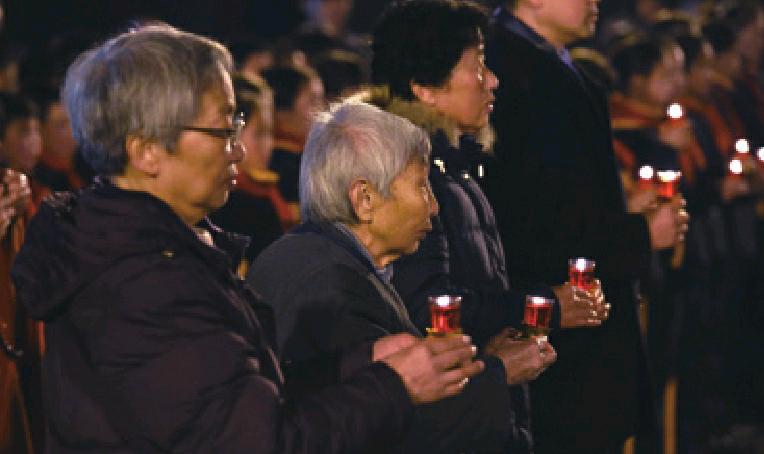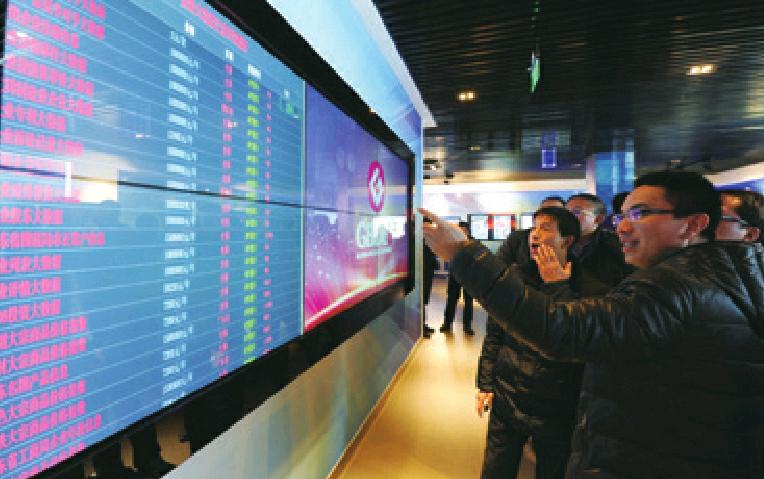Memorial Day
2016-01-15
A candlelight memorial for victims of the Nanjing Massacre is held in Nanjing, Jiangsu Province, on December 13.
Japanese troops captured Nanjing on December 13, 1937, where they killed more than 300,000 civilians and unarmed Chinese soldiers. In 2014, China designated December 13 of each year as the National Memorial Day for Nanjing Massacre Victims.
Residence Permits
From next year, an interim regulation on Chinas residence permit system will ensure access to basic public services while encouraging local governments to provide better services.
“Basic” public services include items such as education, basic employment services, passports, automobile registration, etc. The regulation will make public services available to more citizens and promote social equity, said a statement of the State Council, Chinas cabinet, on December 12.
The regulation is part of changes being made to the household registration, hukou, system. Most public services in China are linked with hukou.
China used to implement a temporary residence permit system for the migrant population, which was widely criticized for injustice and inequity. In February, the top leadership approved major reforms of the police system, abolishing temporary residence permits.
The new residence permit system has taken effect in several big cities.
Credit Ratings
The China Food and Drug Administration announced on December 15 that a credit-rating system will be introduced into the food and drug industries.
The authorities plan to collect information about the credit standing of food and drug producers and sellers to prepare a data bank by the end of 2016, according to a set of guidelines released by the administration. The database will be worked out by the end of 2020, the document said.
All enterprises in the food and drug industries will be rated as A, B, C or D, respectively, in accordance with a national standard. The rating of C refers to lack of credit worthiness while D means an acute shortage of credit worthiness.
According to the guidelines, food and drug businesses with bad credit ratings will be harshly punished and such information about their credit standing will be made public.
Map Regulations
China released new regulations on maps on December 14 to boost development of the geographic information industry.
Included in the new regulations, which will go into effect on January 1, 2016, is a new chapter on online map services, as well as new rules on compiling maps.
The new regulations state that China will promote innovation and application of geographic information science and technology, establish a healthy mechanism for sharing geographic information resources and advance public service.
Online map services should ask users permission before collecting and using information, according to the regulations. They are also required to stop transmitting and report to related authorities when contents that are not allowed to be shown are detected during map information transmission.
The regulations also stipulate that entities compiling maps shall possess mapping qualifications, and governments shall provide free use of nonprofit maps to the public and update the maps regularly.
Relocation Program
China will spend 600 billion yuan($92.58 billion) in the next five years to relocate about 10 million impoverished people, an official said on December 15.
The investment at all government levels should match the determination of the Central Government in fighting poverty, Su Guoxia, a spokeswoman for the State Council Leading Group Office of Poverty Alleviation and Development, said at a press conference. In 2016, spending on poverty alleviation by central and provincial governments will increase by a large margin, according to Su.
On December 7, the Communist Party of China Central Committee and the State Council released a poverty alleviation instruction. The document followed a high-profile conference on the issue in Beijing late in November, during which the leadership pledged measures to help lift the countrys remaining 70 million poor people out of poverty by 2020.
The policy guideline calls for creative ideas and methods to ad-dress poverty and accelerating the relocation of poor people living in tough circumstances with fragile ecosystems or prone to natural disasters.
Policy banks are supposed to provide favorable long-term loans for the relocation and the central budget should pay 90 percent of the interest, according to the document.
Full 4G Coverage
China aims to cover all its urban and rural areas with 4G wireless service by 2018, according to an action plan published by the Ministry of Industry and Information Technology (MIIT) on December 14.
The country also plans to install fiber optics in more than 80 percent of its villages, according to a threeyear action plan of the ministry.
With regard to the upgrading of network infrastructure, the MIIT set the target of “completing a broadband-based, integrated, ubiquitous and secure next-generation national information infrastructure.”
To achieve this, China will channel more energy into the promotion of 4G, and boost research and development of 5G mobile networks, according to the action plan.
The action plan promises efforts to integrate mobile Internet, cloud computing, big data and the Internet of Things with modern manufacturing to encourage the healthy development of e-commerce, industrial networks, and Internet banking, and to help Internet companies increase their international presence.
The First School
A teacher gives a lesson at Yongxing School in Chinas southernmost city, Sansha, on the Xisha Islands, on December 14.
Yongxing School, including a primary school, a kindergarten and a vocational education center, is the first teaching institution ever opened in Sansha.
Sansha in Hainan Province was officially established in 2012 to administer Xisha, Zhongsha and Nansha island groups and surrounding waters in the South China Sea.
UNESCO Center
Beijing will build a UNESCO (UN Educational, Scientific and Cultural Organization) international center for creativity and sustainable development, the first of its kind, said Yan Aoshuang, head of the Beijing Municipal Science and Technology Commission, on December 14.
Yan said that the center will include the establishment of a global creativity bank and a network for sustainable development.
Francesco Bandarin, Assistant Director General for Culture of UNESCO, said at a seminar that the center will promote cultural and creative industries and the global flow of cultural products and services.
In November, the 38th Session of the UNESCO General Conference approved the founding of the center in Beijing.
New Campus
Northwest Chinas Xinjiang Uygur Autonomous Region on December 10 inaugurated its first national-level university—the China University of Petroleum campus in Karamay, a renowned oil town.
It will help improve innovation and economic competitiveness in Xinjiang, said Arken Tuniyaz, Vice Chairman of the Xinjiang Regional Government, at the inauguration ceremony.
The campus, covering 480 hectares, cost 4.3 billion yuan($663 million). It will begin to enroll students for the academic year beginning in September 2016. In the next five to eight years, it is expected to have 8,000 students.
Karamay was the location of Chinas first large-scale oilfield 60 years ago.
New Subway
Passengers take selfies on a train of the first subway line in Qingdao, Shandong Province, on December 16.
The 12-km-long line was put into operation on December 16. A one-way trip takes about 19 minutes.
Tigers Home Wild Siberian tigers are doing well in northeast Chinas Heilongjiang Province, thanks to the improved environment and ban on commercial logging.
According to the Heilongjiangs Environmental Protection Department, the reserve area on the Chinese side has reached 1.81 million hectares, accounting for about 3.8 percent of the province.
Among the worlds most endangered large mammals, Siberian tigers mostly live in northeast China and eastern Russia. A China-Russia cross-border nature reserve has become an important migration corridor for them.
China has seen increasing reports of tigers and bears crossing into its territory from Russia. In 2014, two Siberian tigers released into the wild by Russian President Vladimir Putin wandered into China.
Investment Data
Foreign direct investment (FDI) into Chinas mainland rose 1.9 percent year-on-year to 64.9 billion yuan($10.36 billion) in November, the Ministry of Commerce (MOFCOM) said on December 11.
Growth slowed from a 4.2-percent rise in October. For the first 11 months, FDI, which excludes investments in the financial sector, stood at 704.33 billion yuan ($114.04 billion), up 7.9 percent from the same period last year.
During the period of January to November, foreign investment in the service industry rose 18.8 percent, with the hi-tech service sector seeing a jump of 51.7 percent to $7.23 bil- lion. Hi-tech manufacturing attracted$8.54 billion of foreign investment, up 11.7 percent and accounting for 23.8 percent of the total amount of foreign investment in manufacturing.
MOFCOM also noted that more foreign firms invested in China through mergers and acquisitions, accounting for 14.7 percent of the total FDI from January to November, up from 5.6 percent in the same period last year.
On the other hand, the Chinese mainland made $104.13 billion in non-financial investments in overseas markets during the first 11 months of 2015, up 16 percent year-on-year, MOFCOM said on December 15.
Chinese companies are building 75 economic and trade cooperation zones across 34 countries, generating $18 billion of investment and attracting 1,141 Chinese firms, according to the ministry.
It also attributed the fast growth in outbound direct investment to the Belt and Road Initiative, the acceleration of international industrialcapacity cooperation, competitive companies and a more favorable business environment.
EBRD Shareholder
The European Bank for Reconstruction and Development (EBRD) announced on December 14 that its board of governors had approved a request made by the Chinese authorities for China to become one of the banks shareholders.
“Chinas membership of the EBRD will open up significant opportunities for sustainable investment by Chinese groups in the regions where the EBRD works,”said the EBRD president Sir Suma Chakrabarti in a statement made by the bank.
EBRDs existing shareholders are now comprised of 64 countries and two international organizations.
The bank also stated that it saw “a lot of scope for working with Chinese companies on projects in its regions that meet the Banks criteria for investment.” It also expressed readiness to work with the Beijing-based Asian Infrastructure Investment Bank.
The EBRD is committed to the goal of enhancing the progress of“market-oriented economies and the promotion of private and entrepreneurial initiative.” It opened business, with its headquarters in London, in April 1991.
Big Data, Big Future
Visitors observe real-time transactions happening at the big data application center in Guiyang, capital of southwest Chinas Guizhou Province, on December 15.
Guizhou has been actively cultivating the electronic information industry as a new sector for growth, including the big data market. The output value of the big data industry is expected to reach 110 billion yuan ($17.02 billion) by the end of this year.
Yuan Convertibility
China has approved the yuans convertibility on the capital account within a prescribed limit of $10 million for the Tianjin, Guangdong and Fujian free trade zones (FTZs), said the Peoples Bank of China, the central bank, in a statement on December 11.
The move represents a historic step in efforts made by China to open up its capital accounts. China had allowed yuan convertibility on its trade accounts nearly two decades ago, but almost all capital account transactions on the mainland are under varying degrees of control.
The announcement came less than two weeks after the yuan was admitted by the International Monetary Fund into its Special Drawing Rights basket alongside the U.S. dollar, euro, British pound and Japanese yen on November 30. For each domestic institution registered in the FTZ and outside of the negative list, the cap was set separately for both the cross-border revenue and expenditures on yearly basis, according to the central banks guidelines issued on December 11, aiming to provide financial support to the FTZs.
Green Taxis
A staff member of a recharging station explains safety rules to the drivers of taxis operating solely on electricity in Sanhe, north Chinas Hebei Province.
On December 13, Hebeis first electric taxi project was launched, with 50 of the vehicles and three recharging stations being put into use in the city.
Shipping Merger
The State Council has approved the merger of the countrys top two shipping conglomerates.
“With the approval of the State Council, the China Ocean Shipping(Group) Company (COSCO) and the China Shipping (Group) Company (China Shipping) will be restructured,” the StateOwned Assets Supervision and Administration Commission said in a statement on December 11.
The move will improve the competitive edge of major Chinese shipping lines by realizing economies of scale, as the global shipping industry faces the impact of a possible long-term downturn, according to statements from the two companies.
“Both COSCO and China Shipping have struggled to be competitive, with overlapping investments, high costs, similar business operations and industrial chains,”read the statement.
COSCO has an annual freight volume of over 400 million tons, with more than 700 ships whose total deadweight reaches 51 million tons. China Shipping has more than 530 ships, amounting to 36 million tons of deadweight.
SOE Reforms China is to launch pilot reforms for state-owned enterprises (SOEs) throughout 10 areas in 2016, including changes in ownership and executive hiring policies, a senior official said on December 11.
Peng Huagang, Deputy Secretary General of the SASAC, made the remarks at a press briefing in Beijing.
The reforms will cover functions and the power of directors, professional managers, investment, mergers and acquisitions, and information disclosure, among others, Peng said.
The measures are part of an SOE guideline issued in September to turn the enterprises into fully independent market entities. By 2020, SOEs are expected to become more robust and influential and have greater ability to avoid risks.
China has about 150,000 SOEs, which hold over 100 trillion yuan($15.5 trillion) in assets and employ more than 30 million people. Any reform to the sector will have a significant effect on the economy as a whole.
Currency Swap Deal
A ceremony marking the start of a currency swap deal between Chinas yuan and Tajikistans somoni was held on December 13 in Urumqi, capital of northwest Chinas Xinjiang Uygur Autonomous Region.
In September, the central banks of China and Tajikistan signed the currency swap agreement, which allowed the two sides to exchange payments in one currency for equivalent amounts in another. The agreement was reached to facilitate bilateral trade settlements and provide liquidity support to financial markets.
The deal, worth 3 billion yuan($470 million), will last for three years and can be extended if both sides agree to it.
China became Tajikistans second largest investor and third largest trade partner as of 2014.
Red-Hot Business
A farmer from Wuqiao County, north Chinas Hebei Province, harvests peppers on December 15. The county is expected to produce 24 million kg of peppers this year, bringing 150 million yuan ($23.2 million) of income for over 8,000 pepper-growing households in the county.
